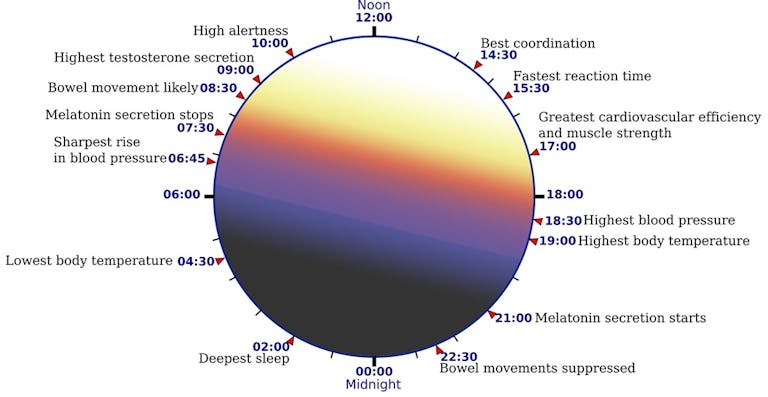I have read a lot of posts lately that give broad recommendations based on circadian rhythms or the idea that certain hormones or biological systems are high or low at different times of the day.
Don’t drink coffee at this time, but drink coffee at this time, work out at this time, eat carbs at this time, and on down the line. This may be a great way to get clicks, but these generalizations are likely ineffective for any one individual, and perhaps even dangerous.
Many people know about cortisol which peaks in the morning to wake us and then dwindles as the day progresses. Melatonin on the other hand wanes in the morning and creeps back up to its peak in the evening allowing us to go to sleep. Both ideally and theoretically.
Melatonin and cortisol are not the only peaks and valleys in the system, but without getting them back in step you won’t be able to correct other hormonal imbalances.
Every hormone in the body is pulsatile and the brain is constantly collecting data and adapting to whatever situation we give it.
New Mood® Has Been Shown To Help Battle Daily-Stress. Try It Free Now For A Limited Time Through This Offer.
Cortisol Dysregulation & Circadian Rhythms
Dr. Gottfried puts cortisol dysregulation at 92% of the population. We don’t live in a primal world. Some people never see the sun, let alone feel it on their skin. We can do anything we want whenever we want. We aren’t active throughout the day, but instead exercise in spurts.
90 cents of every dollar we spend on food is thrown away on processed garbage which dismantles our internal clocks through blood sugar spikes, insulin surges, and food sensitives/allergies.
Most of our lives are not ideal, and thus theoretically most Americans do not have intact circadian rhythms. I haven’t tested a single person with a normal cortisol rhythm on an Adrenal Stress Index (and I service a high end demographic in one of the healthiest cities in the United States).
In fact, I rarely ever run them because we can save money and work on lifestyle changes to actually fix the underlying problem instead. If they need buy in, I’ll order the panel and explain to them that their HPA axis is struggling and/or dysregulated.
Sometimes people need to see numbers, sometimes they don’t. You have to decide how long of a lever you need to move the client to the correct actions for them.
Hans Seyle founded various stages of “Adrenal Fatigue”, however, I don’t believe in the linearity of those stages. For most people, adrenal burnout or fatigue is likely brain based (only a very small portion of the population has actual Addison’s disease or the destruction of adrenal tissue).
As Nora Gedgaudas puts it, the adrenal glands are just hormone factories doing what they are told to do. To fix the problem you have to change the message to and from the brain, and this is why adrenal fatigue supplement protocols are a waste of money without appropriate lifestyle change.
You can’t out supplement lifestyle, no matter how much vitamin C and adrenal glandulars you are inhaling. Sometimes you may need supplements to correct certain issues you can’t fix with lifestyle alone, but ultimately you have to change the message to the brain by breaking the stress response and telling the body there is not a charging bison and a five alarm fire around every street corner.
This again is highly individual and you have to figure out what their stressors are: environmental, over-exercising, under-exercising, emotional stories they replay again and again in their heads, underlying infections, blood sugar swings, food intolerances, and/or a combination of the above.
The Most Common Example of Cortisol Dysregulation
Now say you have a client who comes to you and claims to be an Owl. They are most productive in the evening and wouldn’t dream of going to bed before midnight. They “feel” fine, but crave sugar, and get irritable between meals. They also wouldn’t dream of eating a big breakfast.
The first and most common form of cortisol dysregulation is an inverted rhythm. Meaning cortisol is higher at night than in the morning. Due to this rhythm, this person feels dog tired in the morning and progressively gets more energy as the day goes on.
They may still get really tired in the afternoon if this has been going on for a long time, but then they catch a second wind and perk back up in the evening. Due to cortisol being high in the evening, they aren’t going to be able to get a good night’s rest and the horrific cycle continues.
Now say a trainer has read some chronobiology texts and believes in the Owl vs. Lark philosophy. Great, no problem, but you better damn well know that your client is in an ideal state before you go justifying having them work out at 6pm, which will likely push their circadian rhythm back even farther and feed the underlying problem.
This is because if they are in the above pattern of cortisol dysregulation what they need to do is exactly the opposite of what they will want to do.
They first need to reestablish their cortisol awakening response which can be done with a very short bout of exercise upon waking (talking 5-10 min), they have to eat something for breakfast that has protein and fat, and they have to control their blood sugar throughout the day.
They then need to do cover all the other aspects involved in building health: investigate underlying and unseen causes of stress, limit work and emotional stress whenever possible, move every day, get sunlight especially in the morning, and unplug at night.
But none of those other strategies will work if you just let them do what they want.
They may hate you for a time, but in two months when they feel better than they ever have and are sleeping like a baby from 10pm to 6am, you will be the hero.
And if they are in fact an Owl and have given it their best shot, done some serious healing, and you retest their rhythm and it is normal, then you can play with pushing some things back.
Hack Your Sleep Hormones & Optimize Your Sleep
We are animals and we live with the sun, the moon, and also with the seasons. We have daily, monthly, and seasonal rhythms. Our culture has thrown away these ebbs and flows and replaced them with 24 hour grocery stores with every color food you could dream of.
This is only bad if you let it be, but making the assumption that we can construct and popularize rash generalizations on what rhythm every person should have is asinine and dangerous.
Biological rhythms live with the individual and should be treated as such. We must look objectively at the situation and collect data whether it is in the form of an ASI, blood work, and/or questionnaires.
Then we must further individualize the recommendations to maximize adherence because that ultimately is all that matters.
Are you an insightful enough professional to ask the hard questions and to figure out how to get the results very few can?
Are you a coach who is athlete centered and not tied to what you think should happen or what worked for you?
Are you a client who is receptive and confident enough to live outside the norms of a society that is smothering the essence of what it means to be human with concrete, anti-depressants, and flashing lights?


)





